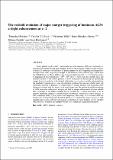Files in this item
The redshift evolution of major merger triggering of luminous AGN : a slight enhancement at z∼2
Item metadata
| dc.contributor.author | Hewlett, Tim | |
| dc.contributor.author | Villforth, Carolin | |
| dc.contributor.author | Wild, Vivienne | |
| dc.contributor.author | Mendez-Abreu, Jairo | |
| dc.contributor.author | Pawlik, Milena | |
| dc.contributor.author | Rowlands, Kate | |
| dc.date.accessioned | 2017-05-29T14:30:12Z | |
| dc.date.available | 2017-05-29T14:30:12Z | |
| dc.date.issued | 2017-08 | |
| dc.identifier | 250119476 | |
| dc.identifier | 6e68ce4b-b9bf-4d8d-aebc-cb12354424d1 | |
| dc.identifier | 85021811216 | |
| dc.identifier | 000406842600047 | |
| dc.identifier.citation | Hewlett , T , Villforth , C , Wild , V , Mendez-Abreu , J , Pawlik , M & Rowlands , K 2017 , ' The redshift evolution of major merger triggering of luminous AGN : a slight enhancement at z∼2 ' , Monthly Notices of the Royal Astronomical Society , vol. 470 , no. 1 , pp. 755-770 . https://doi.org/10.1093/mnras/stx997 | en |
| dc.identifier.issn | 0035-8711 | |
| dc.identifier.other | BibCode: 2017arXiv170503769H | |
| dc.identifier.uri | https://hdl.handle.net/10023/10872 | |
| dc.description | TH was supported by STFC grant ST/M503812/1 during the course of this work. VW, JM-A, MP and KR acknowledge support from the European Research Council Starting Grant SEDmorph (P.I. V. Wild). | en |
| dc.description.abstract | Active galactic nuclei (AGN), particularly the most luminous AGN, are commonly assumed to be triggered through major mergers, however observational evidence for this scenario is mixed. To investigate any influence of galaxy mergers on AGN triggering and luminosities through cosmic time, we present a sample of 106 luminous X-ray selected type 1 AGN from the COSMOS survey. These AGN occupy a large redshift range (0.5 < z < 2.2) and two orders of magnitude in X-ray luminosity (∼1043 - 1045 erg s-1). AGN hosts are carefully mass and redshift matched to 486 control galaxies. A novel technique for identifying and quantifying merger features in galaxies is developed, subtracting galfit galaxy models and quantifying the residuals. Comparison to visual classification confirms this measure reliably picks out disturbance features in galaxies. No enhancement of merger features with increasing AGN luminosity is found with this metric, or by visual inspection. We analyse the redshift evolution of AGN associated with galaxy mergers and find no merger enhancement in lower redshift bins. Contrarily, in the highest redshift bin (z∼2) AGN are ∼4 times more likely to be in galaxies exhibiting evidence of morphological disturbance compared to control galaxies, at 99% confidence level (∼2.4σ) from visual inspection. Since only ∼15% of these AGN are found to be in morphologically disturbed galaxies, it is implied that major mergers at high redshift make a noticeable but subdominant contribution to AGN fuelling. At low redshifts other processes dominate and mergers become a less significant triggering mechanism. | |
| dc.format.extent | 16 | |
| dc.format.extent | 5476069 | |
| dc.language.iso | eng | |
| dc.relation.ispartof | Monthly Notices of the Royal Astronomical Society | en |
| dc.subject | Galaxies: active | en |
| dc.subject | Galaxies: interactions | en |
| dc.subject | X-rays: galaxies | en |
| dc.subject | QB Astronomy | en |
| dc.subject | QC Physics | en |
| dc.subject | NDAS | en |
| dc.subject.lcc | QB | en |
| dc.subject.lcc | QC | en |
| dc.title | The redshift evolution of major merger triggering of luminous AGN : a slight enhancement at z∼2 | en |
| dc.type | Journal article | en |
| dc.contributor.sponsor | European Research Council | en |
| dc.contributor.institution | University of St Andrews. School of Physics and Astronomy | en |
| dc.identifier.doi | https://doi.org/10.1093/mnras/stx997 | |
| dc.description.status | Peer reviewed | en |
| dc.identifier.url | http://adsabs.harvard.edu/abs/2017arXiv170503769H | en |
| dc.identifier.grantnumber | ERC-2012-StG-20111012 | en |
This item appears in the following Collection(s)
Items in the St Andrews Research Repository are protected by copyright, with all rights reserved, unless otherwise indicated.

